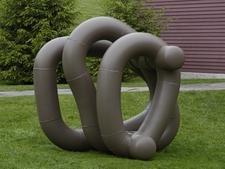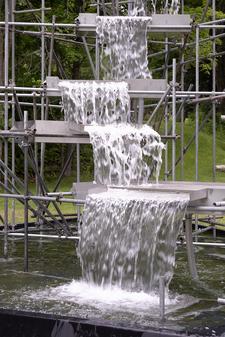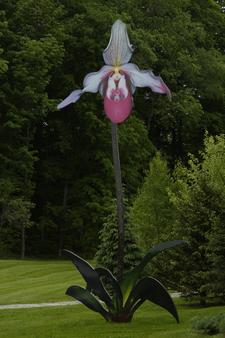
Richard Deacon (b. 1949) has been a leading figure in British sculpture since the 1980s. He describes himself as a fabricator who constructs objects using manufacturing or building techniques, rather than as a sculptor who carves or models. In a career spanning more than four decades, Deacon has worked with a diverse range of materials including laminated wood, stainless steel, corrugated iron, polycarbonate, marble, clay, vinyl, foam and leather. Working on both domestic and monumental scales, he manipulates his materials to create structures that combine organic and biomorphic forms with elements of engineering.
Deacon’s Untitled 1991 (1991), made of painted welded steel, consists of three vertical loops intersected and linked along their top and bottom horizontal axes. Using a technique called heat-line bending, Deacon transforms a flat plate of steel into a three-dimensional and organic form. The anthropomorphic shapes, resembling eyes, ears or open mouths, are joined together in a dynamic and airy structure that contradicts the rigidity and heaviness inherent to the material of steel. The welding lines are purposefully revealed to emphasize the work’s structure and “fabricated” status. With its overlapping arcs and undulating curves, the sculpture presents complex shapes and intersections from every angle.
Throughout the past two decades, the installations, paintings, photography, films, and public projects of Danish-Icelandic artist, Olafur Eliasson (b. 1967), have served as tools for exploring the cognitive and cultural conditions that inform our perception. Ranging from immersive environments of color, light, and movement to installations that recontextualize natural phenomena, his work defies the notion of art as an autonomous object and instead positions itself as part of an active exchange with the visitor and his or her individualized experience. Described by the artist as “devices for the experience of reality,” his individual works and projects prompt a greater sense of awareness about the ways we both interpret and co-produce the world. By recreating the natural through artificial means and capturing it in both time and space, Eliasson's work encourages the renegotiation of linear perceptions of space as well as the line between reality and representation.
Eliasson’s Waterfall (2004) confronts fundamental perceptions of nature while addressing notions of space and movement. Using everyday industrial scaffolding and a system of plastic pumps that cycle the water, the artist evokes the site, sounds and rhythms of a natural waterfall, while also exposing the mechanics behind its construction and movement. Blurring the lines between the natural and constructed, this work invites viewers to reconsider their own experiences of nature, contemplating not just what they see, but how they see.
British artist Marc Quinn (b. 1964) is known for making work that challenges the boundaries between art and science. Using a wide range of media including ice, glass, metal, marble and lead, Quinn’s work addresses the transience of human life through scientific knowledge and artistic expression.
Standing at nearly 20 feet tall, Quinn’s The Incredible World of Desire (Phragmipedium Sedenii) (2003 – 2004) appears to the human eye like what a real orchid must look like to a bee. A highly detailed and colorful photographic image of a Phragmipedium Sedenii orchid has been transferred onto a stainless steel framework. Monumental from the front and back, the sculpture appears as a simple line in space when viewed from the side. Quinn has described the effect as resembling a "flower superimposed on to the landscape” in a way that reminds him “of an image stuck on the front of a child's plastic toy."
The Incredible World of Desire (Phragmipedium Sedenii) (2003 – 2004) evolved from a series of works that Quinn made using silicone to freeze real flowers, including various types of orchids, in perfect bloom. Of all plants, Quinn describes his fascination with orchids in particular:
Orchids are like perfectly evolved little sculptures in themselves, they're full of colour, interesting shapes and beauty. Even though they are a plant's reproductive organs, they pun on human ones too. They make you realise it is colour, life and sexuality that keeps the world turning. They are a celebration of life. I like all kinds of flowers, irises, sunflowers and anthuriums are great but none are quite as good as orchids.
Wild orchids are often considered to be a symbol of fertility, purity and spiritual perfection. The Incredible World of Desire (Phragmipedium Sedenii) (2003 – 2004) is meant to “advertise the wonder of life” and to remind us, as Quinn puts it, of “the overwhelming sensuality of the natural world, whose life force is one of pure desire.”
The Hall Art Foundation in Reading, Vermont is open weekends by appointment.
Appointments are available Saturdays and Sundays at 11 AM and 2 PM.
Admission: $10 pp
The First Friday of every month, from 5 - 8 PM, we also welcome visitors to view our exhibitions without a guide and at their own pace. Admission is free!
Donations to help support our programming are always appreciated.
544 VT Route 106
Reading, VT 05062
For more information and images, please contact the Foundation’s administrative office at + 1 802 952 1056 or info@hallartfoundation.org.

Richard Deacon
Untitled 1991, 1991
Painted welded steel
63 ½ x 60 x 72 inches
Hall Art Foundation
Courtesy Hall Art Foundation
© Richard Deacon

Olafur Eliasson
Waterfall, 2004 (detail)
Scaffolding, water, wood, foil, aluminum, pump, hose
7 x 6 x 10 m
Hall Art Foundation
© Olafur Eliasson

Marc Quinn
The Incredible World of Desire (Phragmipedium Sedenii), 2003-2004
Weather resistant pigment, resin on stainless steel
231 x 102 x 2 ½ inches
Hall Collection
Courtesy Hall Art Foundation
© Marc Quinn
